Everyone is talking impact nowadays. Organisations can’t get away anymore with just reporting about a few outputs, such as the number of people they have reached or the number of schools they have built. Nowadays, they also need to understand, report about and be accountable for the change (both positive and negative) that is created by their activities. Did the intervention actually make a lasting difference in people’s lives? Since such results generally only occur after a longer period of time, sometimes even years after a programme or intervention was initiated, measuring impact can be challenging. Especially determining to what extent your intervention contributed to the change may be a tough task. How much of the results can you claim? And how do you calculate your impact claim?
Topics: Social impact, Social Return on Investment, sroi, impact claim
Tijdens het recente debat ‘Welvaart in Kaart’ in de Tweede Kamer riep Kamerlid Marianne Thieme op om op zoek te gaan naar andere indicatoren voor beleid dan geld. “Waarom laten we ons vangen in economische cijfers, die niets zeggen over de kracht van onze gemeenschapszin?” En “waarom willen we alles meten en in geld uitdrukken, behalve dat wat het leven echt de moeite waard maakt?”, zo vroeg ze zich enigszins geërgerd af. En wellicht terecht, want beleidsmakers en politici baseren zich nog veelvuldig op de Macro Economische Verkenningen, die vaak als belangrijke leidraad worden gebruikt bij het ontwikkelen van nieuw beleid. Hoewel deze rapportages belangrijke inzichten verschaffen, zeggen ze nauwelijks iets over welvaart in de breedste zin van het woord. De benadering is met name financieel-economisch van aard. Het is dan ook van belang dat er gezocht wordt naar indicatoren die immateriële waarde centraal stellen, om die vervolgens te kunnen gebruiken bij het ontwikkelen van nieuw beleid.
Topics: gemeente, overheid, maatschappelijke impact, sroi, maatschappelijke waarde, indicatoren, welvaartsbegrip, waarde
Sinzer recently announced a formal Data Partnership with the Global Value Exchange (GVE). We are presenting a series of blogs with more detailed information about the data sources GVE uses to extract outcomes, indicators and valuations from. This week we highlight the TEEB Valuation Database, from which more than 200 valuations have been extracted and added to the GVE database. As a result of our data partnership with the GVE, these valuations can now also be accessed on the Sinzer platform.
Topics: valuations, sroi
-1.jpg?width=232&name=GT%20Sinzer_logo_screen_descriptor%20(1)-1.jpg)



